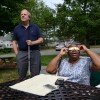On Monday, Massachusetts Superior Court Judge Raymond Veary, Jr., granted a new trial to Fred Weichel, a man convicted of murder thirty-six years ago. Weichel’s lawyers and other observers have asserted that he did not commit the crime that gave rise to the murder charge. For purposes of full disclosure, I am on the Board of Trustees of the New England Innocence Project, a local organization that served as one of Weichel’s lawyers in the recent proceedings.
A jury convicted Weichel of murdering Robert LaMonica outside of his apartment in Braintree late one night in 1980. The police had few leads besides a teenager who claimed to have seen the perpetrator jump into a car and drive away from the scene. This witness – who had just completed a six-pack of beer and was about 180 feet away – helped the police develop a composite sketch of the assailant. Later, while driving around South Boston with the police, the teenager saw Weichel on the street and identified him. Weichel maintained his innocence from the start, insisting he was in a Boston bar at the time of the killing. Nevertheless, the jury rejected Weichel’s alibi defense, convicted him, and he was eventually sentenced to life in prison.
Weichel’s supporters have long viewed the identification evidence as the weak link in the case but struggled to find a legal hook to substantiate that theory. That changed in 2010 when evidence surfaced about a police report compiled in 1980 by a Braintree Police Detective. That report indicated that multiple state corrections officers had informed the detective that the composite sketch resembled Rocco Balliro, a former inmate who pleaded guilty to another murder and had been released from prison on furlough the day before LaMonica’s murder. Yet this evidence was never disclosed to Weichel’s attorneys before trial and only emerged when the new Weichel legal team asked for the entire police file 30 years later. Judge Veary’s ruling cited the failure of prosecutors to turn over this report at the time of trial as a critical event that deprived Weichel of an adequate chance to attack the identification evidence and more generally mount a defense. In the eyes of Judge Veary, that failure warranted a new trial.
Prosecutors expressed disappointment with the ruling, so I imagine they might appeal the decision. Assuming the order for a new trial survives appellate review, I think prosecutors face an uphill climb if they decide to go forward. For one thing, trying a murder case from 37 years ago is challenging even under ideal circumstances for the government. And the circumstances here are less than ideal – a case predicated on a shaky identification by an inebriated teenager. What’s more, there seems to be built-in “reasonable doubt” in the form of the report pointing to Balliro’s involvement. Notably, Balliro died in 2012.
Although prosecutors might push back against characterizing this as a wrongful conviction, the Weichel saga bears similarities with a lot of innocence cases. Eyewitness misidentification is the primary factor in documented exonerations of innocent prisoners, appearing in roughly 70 percent of those cases, and that seems to have been the key variable in Weichel’s conviction. The withholding of exculpatory evidence by prosecutors also appears frequently in the data set of wrongful convictions. To be sure, many of the cases that generate headlines are “DNA cases,” where post-conviction DNA tests are conducted on biological evidence from the crime scene and those results prove the inmate’s innocence. This is not one of those cases. So-called “non-DNA” innocence cases like Weichel’s are often much harder to undertake, involving painstaking fact investigation and a healthy dose of fortuity, as occurred with the discovery of the police report.
The ultimate outcome of the Weichel case is not yet certain. But Judge Veary’s ruling goes a long way toward encouraging fair play on the part of law enforcement and, with that, toward achieving justice.




